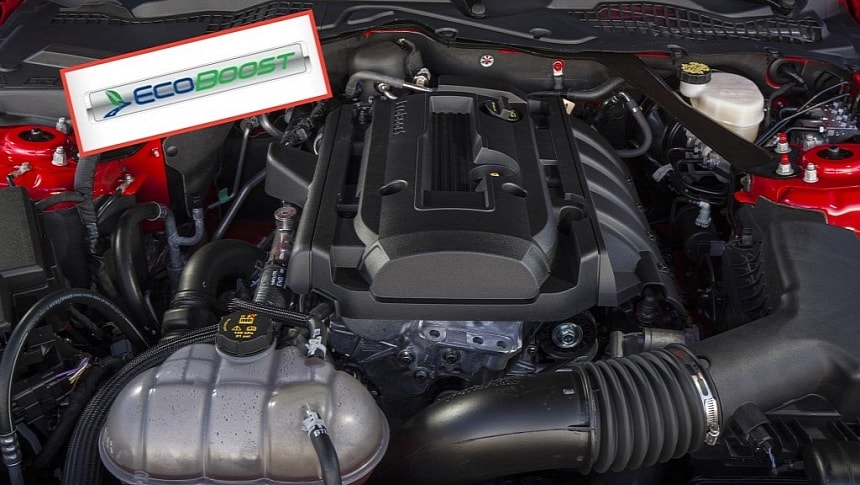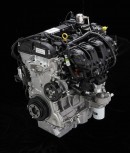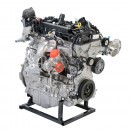To most people – including those who are interested in and those indifferent to all things four wheels – engine families sound like funny names created with no particular reason. However, said engine family monikers actually speak volumes about the sort of performance, gas mileage, and reliability they can expect from each and every model they intend to purchase from their automaker of choice.
The Volkswagen Group has TSI for gas motors and TDI for diesels, whereas the folks at Peugeot have PureTech and BlueHDi. Over in Dearborn, the Ford Motor Company's premiere internal combustion engine families are called EcoBoost and EcoBlue. This guide is about the former, which – as implied – is a portmanteau that connotates fuel savings and forced induction. Rather than supercharged, EcoBoosts are exclusively turbocharged.
Available in all markets where Ford is officially present, EcoBoost is as much a household name as Google, McDonald's, and Coca-Cola. In production since 2009, the EcoBoost was a leap of faith for the second-largest automaker of the Detroit Big Three. For starters, turbocharged engines weren't all that popular in the US during that era. Secondly, customers valued – and still value – reliability and simplicity over increased fuel economy.
Due to increasingly stringent gas mileage and emission regulations, FoMoCo didn't really have a choice but to go all-in with downsized turbo engines. Be it the lowly 1.0L Fox three-cylinder or the big-boy 3.5L EcoBoost six-cylinder, EcoBoosts are designed to deliver power and torque consistent with larger displacement, naturally aspirated engines while also lowering fuel consumption.
EcoBoosts can be categorized after the number of cylinders, displacement, chronologically, and pretty much everything in between if you're really into engines. To keep things nice and simple for those who aren't as mechanically inclined, we'll stick to the displacement for this guide on the Ford Motor Company's award-winning EcoBoost range of three-, four-, and six-cylinder powerplants.
Codenamed Fox, the smallest member of the family was developed at Dunton Technical Centre in the United Kingdom. This fellow rolled out in Ford series-production models in 2012 in models that include Ford's now-defunct Fiesta, B-Max, C-Max, and Focus. In the first year of production, it was rated at either 100 ps (99 hp) and 170 Nm (125 lb-ft) or 125 ps (123 hp) and similar peak torque.
The biggest issue of the 1.0-liter EcoBoost is the notorious oil-bathed timing belt, which – on paper – should be replaced every decade or 150,000 miles (just over 240,000 kilometers). Newer 1.0-liter EcoBoosts feature timing chains that are less prone to disintegrate without any prior warning.
At press time, Ford's most frugal three-cylinder EcoBoost is the mHEV version. Mild-hybrid Ford vehicles may not be capable of electric-only driving, but an electric motor that provides extra torque under acceleration results in better fuel economy. For model year 2024, the Ford Focus 1.0L EcoBoost 125 PS mHEV is good for 5.8 liters per 100 kilometers (62 miles) with the standard manual tranny. In other words, that's 40.5 miles to the gallon US or 48.7 miles to the gallon UK.
Back in 2014, the Ford Motor Company launched the 1.5-liter EcoBoost, a four-cylinder lump derived from the Sigma engine. This four-pot engine shouldn't be confused with the current 1.5-liter EcoBoost, which is known as Dragon. The replacement launched in 2017 with the seventh-generation Fiesta (make that Mk8 in the UK).
The Dragon-engined 2018 Ford Focus launched with 150 ps (148 hp) and 240 Nm (177 lb-ft) on deck, whereas the Fiesta ST leveled up to 200 ps (197 hp) and 290 Nm (214 lb-ft). Ford of Europe's then-product development chief, Joe Bakaj, made it clear that 500 cubic centimeters (actually 499) per cylinder is the sweet spot for thermal efficiency.
As of June 2024, the Ford Motor Company sells two Dragon-powered models in the United States, those being the compact-sized Escape and Escape-based Bronco Sport off-road crossover. An eight-speed automatic transmission comes standard, while maximum output is 181 horsepower and 190 pound-feet (258 Nm) in the case of the Bronco Sport.
This four-cylinder EcoBoost, which is also derived from the Sigma engine, saw the light of day in 2009. It was previewed in the Lincoln C show car, a coach-door hatchback based on the now-obsolete Global C platform of the third-gen Focus. The Bronco Sport and Escape mentioned just earlier feature a platform dubbed C2, which also underpins the Maverick pickup truck and Lincoln Corsair.
The 1.6er was recalled on multiple occasions. Remember the 1.6-liter Escape recalls over fire concerns due to oil and coolant leaks? Overheating issues returned a few years later with a 360,000-vehicle recall affecting the Escape, Fiesta ST, Focus, C-Max, Fusion, and the Transit Connect.
In addition to Ford, this engine was also used by Swedish automaker Volvo in pretty much everything from the V40 compact hatchback to the S80 executive sedan. Lest we forget, FoMoCo used to call the shots at Volvo Cars between 1999 and 2010. The Swedish automaker's current overlord is Zhejiang Geely Holding Group, the Chinese goliath that controls Polestar, Lotus, and smart. As for the most powerful application of the 1.6-liter EcoBoost, said motor developed 197 horsepower and 214 pound-feet (290 Nm) in the Fiesta ST200.
The 2.0-liter EcoBoost premiered in 2008 with the Ford Explorer America concept. It's the very first EcoBoost with twin independent variable cam timing, which Ford shortens to Ti-VCT. Engines produced from 2010 through 2018 are derived from the 2.0-liter Mazda L series. With the second-generation Edge, the Ford Motor Company had completely redesigned the 2.0-liter EcoBoost.
The second generation is often dubbed twin scroll because of its twin-scroll turbocharger. When it comes to mono- versus twin-scroll differences, the biggest advantages of the latter come in the guise of better low-RPM performance and less turbo lag. The downsides are higher overall production costs and slightly poorer high-RPM performance.
Highlight applications of the 2.0-liter EcoBoost with twin-scroll turbocharging include the Bronco Sport (Badlands trim level only) and the Maverick trucklet. Going EcoBoost in the Maverick unlocks another optional extra in the form of all-wheel drive, which further sweetens the deal with a multi-link rear end as opposed to the front-wheel-drive Maverick's twist beam-style rear suspension.
Similar to the 2.0-liter EcoBoost, the 2.3-liter sibling can be categorized into two generations. The introduction of the 2024 model year Ford Mustang saw the Ford Motor Company debut a redesigned 2.3-liter EcoBoost, which is referred to as MPC.
Modular Power Cylinder tech refers to an engine architecture aimed at keeping design continuity across the 1.5-liter Dragon, the 2.0-liter twin scroll, and the 2.3-liter EcoBoost. Arguably the biggest change over the original 2.3-liter EcoBoost is dual injection, as in direct fuel injection and port fuel injection. Although more complex, this particular setup diminishes each injection system's negatives. Think carbon build-up in DI-exclusive motors.
The most powerful 2.3-liter EcoBoost in production at the moment of writing is the MPC unit of the S650-generation Mustang, which makes 315 horsepower and 350 pound-feet (475 Nm). In the Ford Ranger, said four-pot mill is rated at a more conservative 270 hp and 310 lb-ft (420 Nm). For 2025, the Ranger for Europe will gain a plug-in hybrid setup built around the 2.3-liter EcoBoost.
Although not the first six-cylinder of the family, the 2.7er is the smallest of the lot. Codenamed Nano, this EcoBoost is a twin-turbocharged affair. In fact, all six-cylinder EcoBoosts feature two snails.
The 2015 model year Ford F-150 was the first series-production vehicle to receive this lump. At the time, it made 325 ponies and 375 pound-feet (508 Nm) at 3,000 revolutions per minute. By comparison, the 5.0-liter Coyote V8 of that era produced 387 lb-ft (525 Nm) at 3,850 rpm. The 2.7- and 3.5-liter EcoBoost are the most specified F-150 engines, while the 3.5-liter PowerBoost hybrid accounts for nearly 25 percent of F-150 pickups.
Ford Motor Company refreshed the Nano for the 2018 model year F-150. As part of the refresh, the direct fuel injection system was joined by port fuel injection. The punchiest application thus far is the Ranger-based Bronco, which maxes out at 330 horsepower and 415 pound-feet (563 Nm) on premium fuel. Using regular unleaded results in 315 horsepower and 410 pound-feet (556 Nm).
A development of the 2.7-liter Nano we talked about in the previous three paragraphs, the 3.0-liter Nano wouldn't have been possible without Dearborn's favorite son increasing the cylinder bore from 83 to 85.3 millimeters and lengthening the piston stroke from 83 to 86 millimeters. The 3.0-liter Nano is the newest EcoBoost of bunch, for it had been released for the 2017 model year.
Combining aluminum heads with a compacted graphite iron block, the DOHC sixer obviously boasts twin independent variable cam timing. Originally used by the Lincoln MKZ and Continental, the 2.7-liter EcoBoost presently serves the likes of the Ford Explorer, Lincoln Aviator, Ford Ranger Raptor, and the Bronco Raptor.
The recently discontinued Aviator Grand Touring was the most powerful application of the 2.7-liter EcoBoost because Grand Touring used to mean plug-in hybrid in said context. Without any sort of assistance, it makes 418 horses and 440 pound-feet (597 Nm) on premium dino juice in the Braptor. Regarding the elephant in the room, the Eco in 3.0-liter EcoBoost is wishful thinking in this case because the Bronco Raptor is estimated to average 15 miles per gallon (15.7 liters per 100 clicks).
Can you believe that FoMoCo previewed the 3.5-liter EcoBoost nearly two decades ago in the 2007 Lincoln MKR concept? Ford Motor Company started manufacturing the 3.5er in 2009 for the 2010 Ford Flex, Taurus SHO, Lincoln MKS, and MKT. The F-150 received it for MY 2011, and – believe it or not – said engine also powered a supercar.
The Dearborn-based automaker premiered the second generation of the 3.5-liter EcoBoost at the 2015 Detroit Auto Show in the 2017 model year Ford GT and F-150 Raptor. Once again, the primary change from the first gen is dual injection. Also shared with a British supercar (the Noble M500) and a Portuguese supercar (the Adamastor Furia), the largest EcoBoost of them all tops 660 horsepower and 550 pound-feet (746 Nm) in the 2020 to 2022 Ford GT.
Be that as it may, the real star is the PowerBoost hybrid, which differs from the EcoBoost by means of a transmission-integrated electric motor and a small high-voltage battery. The PowerBoost promises up to 23 miles per gallon (10.2 liters per 100 kilometers) in the F-150, whereas the 2.7-liter EcoBoost can't do better than 21 mpg (11.2 l/100 km) in the combined cycle.
Available in all markets where Ford is officially present, EcoBoost is as much a household name as Google, McDonald's, and Coca-Cola. In production since 2009, the EcoBoost was a leap of faith for the second-largest automaker of the Detroit Big Three. For starters, turbocharged engines weren't all that popular in the US during that era. Secondly, customers valued – and still value – reliability and simplicity over increased fuel economy.
EcoBoosts can be categorized after the number of cylinders, displacement, chronologically, and pretty much everything in between if you're really into engines. To keep things nice and simple for those who aren't as mechanically inclined, we'll stick to the displacement for this guide on the Ford Motor Company's award-winning EcoBoost range of three-, four-, and six-cylinder powerplants.
Ford 1.0L EcoBoost (launched in 2012)
The biggest issue of the 1.0-liter EcoBoost is the notorious oil-bathed timing belt, which – on paper – should be replaced every decade or 150,000 miles (just over 240,000 kilometers). Newer 1.0-liter EcoBoosts feature timing chains that are less prone to disintegrate without any prior warning.
At press time, Ford's most frugal three-cylinder EcoBoost is the mHEV version. Mild-hybrid Ford vehicles may not be capable of electric-only driving, but an electric motor that provides extra torque under acceleration results in better fuel economy. For model year 2024, the Ford Focus 1.0L EcoBoost 125 PS mHEV is good for 5.8 liters per 100 kilometers (62 miles) with the standard manual tranny. In other words, that's 40.5 miles to the gallon US or 48.7 miles to the gallon UK.
Ford 1.5L EcoBoost (launched in 2014 and 2017, respectively)
The Dragon-engined 2018 Ford Focus launched with 150 ps (148 hp) and 240 Nm (177 lb-ft) on deck, whereas the Fiesta ST leveled up to 200 ps (197 hp) and 290 Nm (214 lb-ft). Ford of Europe's then-product development chief, Joe Bakaj, made it clear that 500 cubic centimeters (actually 499) per cylinder is the sweet spot for thermal efficiency.
As of June 2024, the Ford Motor Company sells two Dragon-powered models in the United States, those being the compact-sized Escape and Escape-based Bronco Sport off-road crossover. An eight-speed automatic transmission comes standard, while maximum output is 181 horsepower and 190 pound-feet (258 Nm) in the case of the Bronco Sport.
Ford 1.6L EcoBoost (launched in 2010)
The 1.6er was recalled on multiple occasions. Remember the 1.6-liter Escape recalls over fire concerns due to oil and coolant leaks? Overheating issues returned a few years later with a 360,000-vehicle recall affecting the Escape, Fiesta ST, Focus, C-Max, Fusion, and the Transit Connect.
In addition to Ford, this engine was also used by Swedish automaker Volvo in pretty much everything from the V40 compact hatchback to the S80 executive sedan. Lest we forget, FoMoCo used to call the shots at Volvo Cars between 1999 and 2010. The Swedish automaker's current overlord is Zhejiang Geely Holding Group, the Chinese goliath that controls Polestar, Lotus, and smart. As for the most powerful application of the 1.6-liter EcoBoost, said motor developed 197 horsepower and 214 pound-feet (290 Nm) in the Fiesta ST200.
Ford 2.0L EcoBoost (launched in 2010 and 2015, respectively)
The second generation is often dubbed twin scroll because of its twin-scroll turbocharger. When it comes to mono- versus twin-scroll differences, the biggest advantages of the latter come in the guise of better low-RPM performance and less turbo lag. The downsides are higher overall production costs and slightly poorer high-RPM performance.
Highlight applications of the 2.0-liter EcoBoost with twin-scroll turbocharging include the Bronco Sport (Badlands trim level only) and the Maverick trucklet. Going EcoBoost in the Maverick unlocks another optional extra in the form of all-wheel drive, which further sweetens the deal with a multi-link rear end as opposed to the front-wheel-drive Maverick's twist beam-style rear suspension.
Ford 2.3L EcoBoost (launched in 2015)
Modular Power Cylinder tech refers to an engine architecture aimed at keeping design continuity across the 1.5-liter Dragon, the 2.0-liter twin scroll, and the 2.3-liter EcoBoost. Arguably the biggest change over the original 2.3-liter EcoBoost is dual injection, as in direct fuel injection and port fuel injection. Although more complex, this particular setup diminishes each injection system's negatives. Think carbon build-up in DI-exclusive motors.
The most powerful 2.3-liter EcoBoost in production at the moment of writing is the MPC unit of the S650-generation Mustang, which makes 315 horsepower and 350 pound-feet (475 Nm). In the Ford Ranger, said four-pot mill is rated at a more conservative 270 hp and 310 lb-ft (420 Nm). For 2025, the Ranger for Europe will gain a plug-in hybrid setup built around the 2.3-liter EcoBoost.
Ford 2.7L EcoBoost (launched in 2015)
The 2015 model year Ford F-150 was the first series-production vehicle to receive this lump. At the time, it made 325 ponies and 375 pound-feet (508 Nm) at 3,000 revolutions per minute. By comparison, the 5.0-liter Coyote V8 of that era produced 387 lb-ft (525 Nm) at 3,850 rpm. The 2.7- and 3.5-liter EcoBoost are the most specified F-150 engines, while the 3.5-liter PowerBoost hybrid accounts for nearly 25 percent of F-150 pickups.
Ford Motor Company refreshed the Nano for the 2018 model year F-150. As part of the refresh, the direct fuel injection system was joined by port fuel injection. The punchiest application thus far is the Ranger-based Bronco, which maxes out at 330 horsepower and 415 pound-feet (563 Nm) on premium fuel. Using regular unleaded results in 315 horsepower and 410 pound-feet (556 Nm).
Ford 3.0L EcoBoost (launched in 2016)
Combining aluminum heads with a compacted graphite iron block, the DOHC sixer obviously boasts twin independent variable cam timing. Originally used by the Lincoln MKZ and Continental, the 2.7-liter EcoBoost presently serves the likes of the Ford Explorer, Lincoln Aviator, Ford Ranger Raptor, and the Bronco Raptor.
The recently discontinued Aviator Grand Touring was the most powerful application of the 2.7-liter EcoBoost because Grand Touring used to mean plug-in hybrid in said context. Without any sort of assistance, it makes 418 horses and 440 pound-feet (597 Nm) on premium dino juice in the Braptor. Regarding the elephant in the room, the Eco in 3.0-liter EcoBoost is wishful thinking in this case because the Bronco Raptor is estimated to average 15 miles per gallon (15.7 liters per 100 clicks).
Ford 3.5L EcoBoost (launched in 2010)
The Dearborn-based automaker premiered the second generation of the 3.5-liter EcoBoost at the 2015 Detroit Auto Show in the 2017 model year Ford GT and F-150 Raptor. Once again, the primary change from the first gen is dual injection. Also shared with a British supercar (the Noble M500) and a Portuguese supercar (the Adamastor Furia), the largest EcoBoost of them all tops 660 horsepower and 550 pound-feet (746 Nm) in the 2020 to 2022 Ford GT.
Be that as it may, the real star is the PowerBoost hybrid, which differs from the EcoBoost by means of a transmission-integrated electric motor and a small high-voltage battery. The PowerBoost promises up to 23 miles per gallon (10.2 liters per 100 kilometers) in the F-150, whereas the 2.7-liter EcoBoost can't do better than 21 mpg (11.2 l/100 km) in the combined cycle.

















































